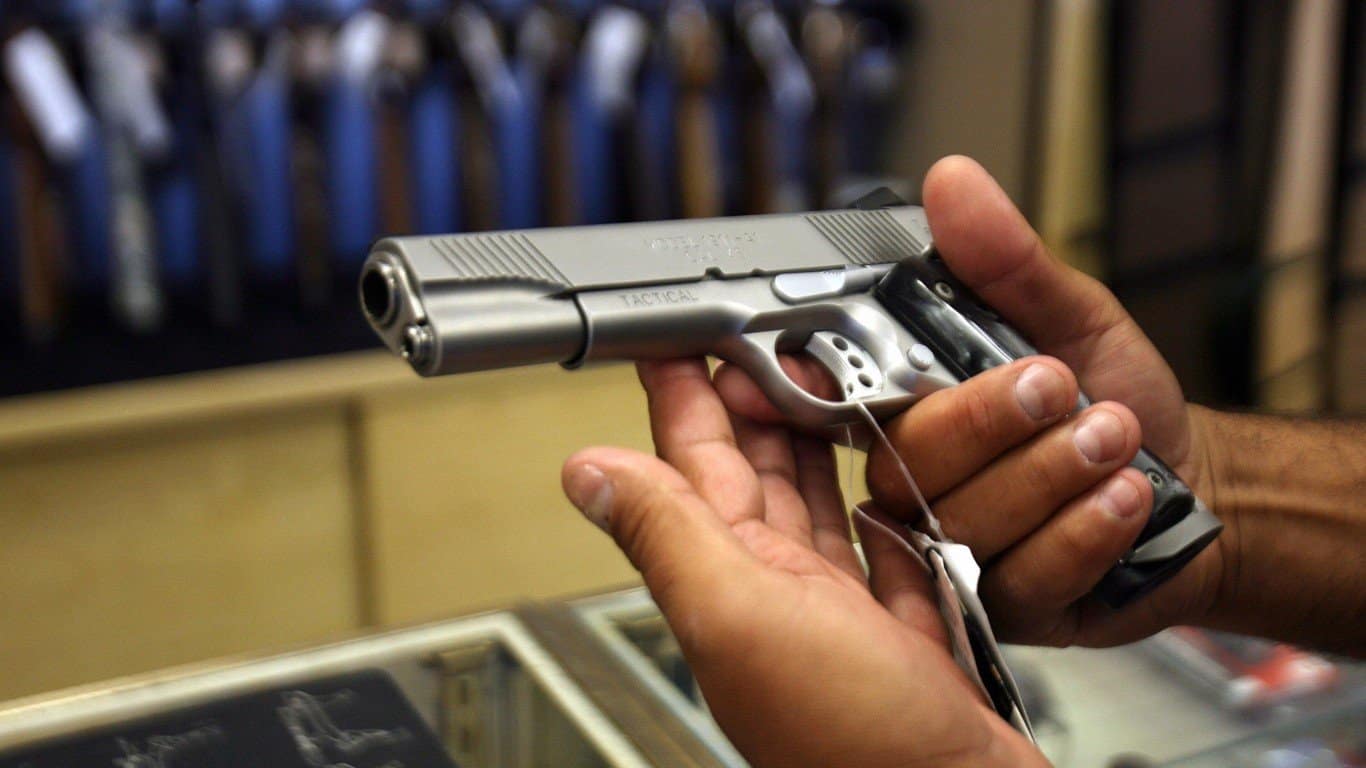As long as the Second Amendment protects the right to bear arms, residents of all 50 states will look to own firearms. However, the reality of gun ownership is that even with the Constitution protecting overall rights, the states can set forth some guidelines around things like concealed carry. Whether you agree to firearm ownership or not, it pays to know all of the laws.
Why We’re Writing About Gun Laws
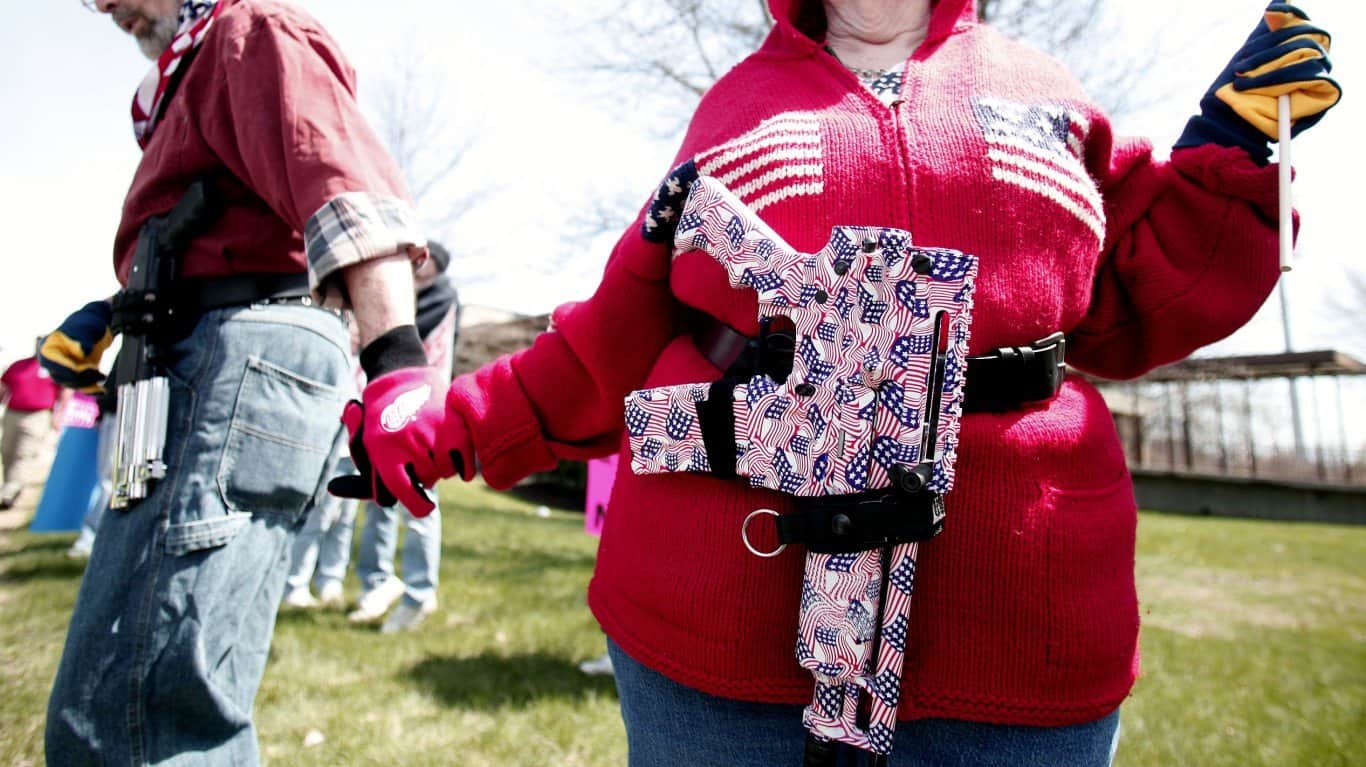
Knowing and understanding gun laws is vital in your home and any state you visit. If you fail to observe these laws, you can get into serious legal trouble and even jailed.
State gun laws vary drastically, and understanding these differences will ensure your safety and right to bear arms responsibly. In addition, state gun regulations can influence property values and insurance rates in certain areas, as well as each state’s social values and political climate.
What Is Concealed Carry?

While the laws across different states vary, concealed carry is relatively the same nationwide. As the name suggests, concealed carry is carrying a concealed firearm, almost always a handgun, physically on your body but in a way that hides or obscures the weapon from anyone who might be observing you.
In some cases, concealed carry can also cover a knife or a stun gun. More importantly, it’s unrelated to any specific type of clothing, as an untucked t-shirt can conceal a weapon as easily as a heavy jacket.
What Is Open Carry?
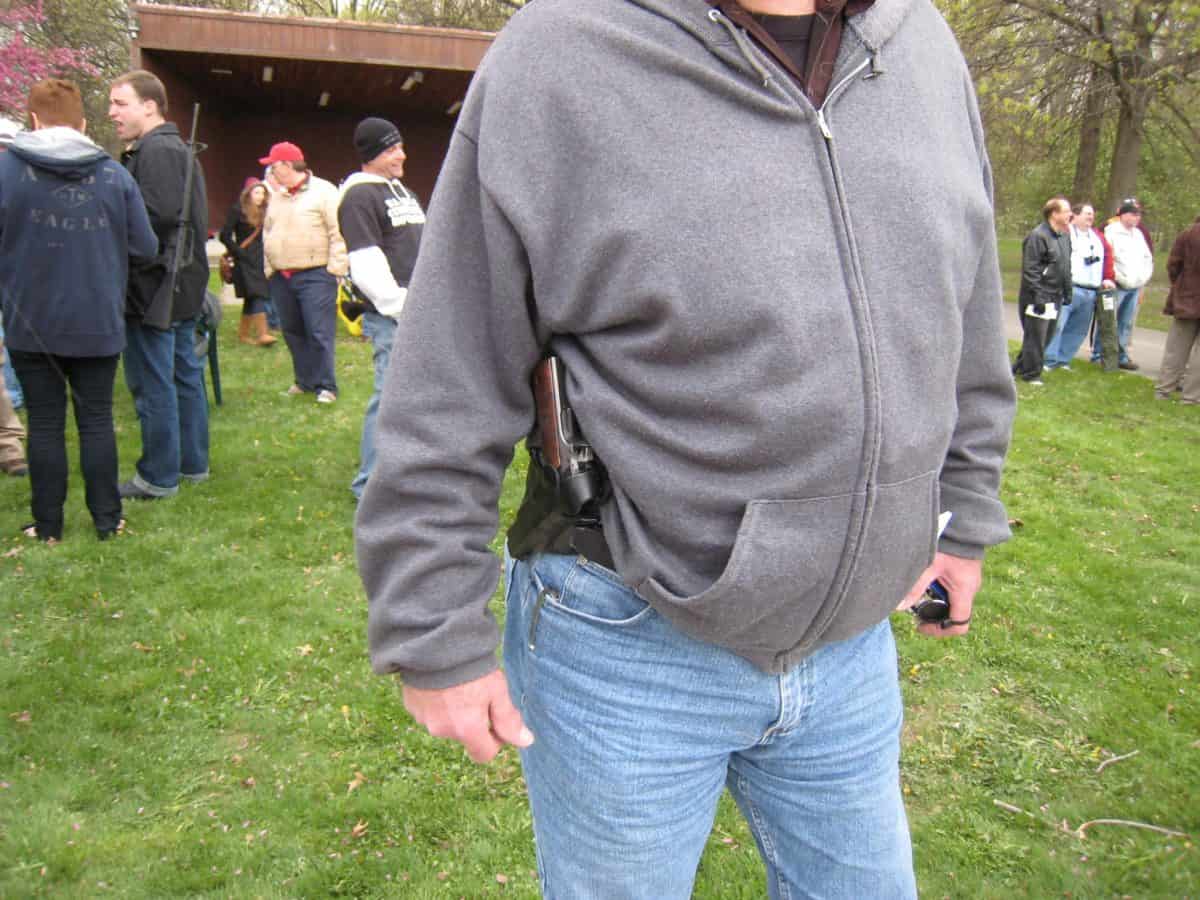
The opposite of concealed carry, Open Carry, is a way that makes it very visible that you have a firearm on you. This might mean carrying the weapon in either a holster on a belt or, in the case of a larger weapon like a rifle, with a sling on your back. The caveat here is that the gun, no matter what type of weapon, cannot be in your hands, firing position, or combat stance.
Any such action could be construed as a threat and would go against open carry laws across the country. Thankfully, all 50 states have laws around open carry that help define precisely what is allowed and not allowed and whether certain types of buildings, like government buildings, will allow the open carry of firearms.
Gun Safety Requirements
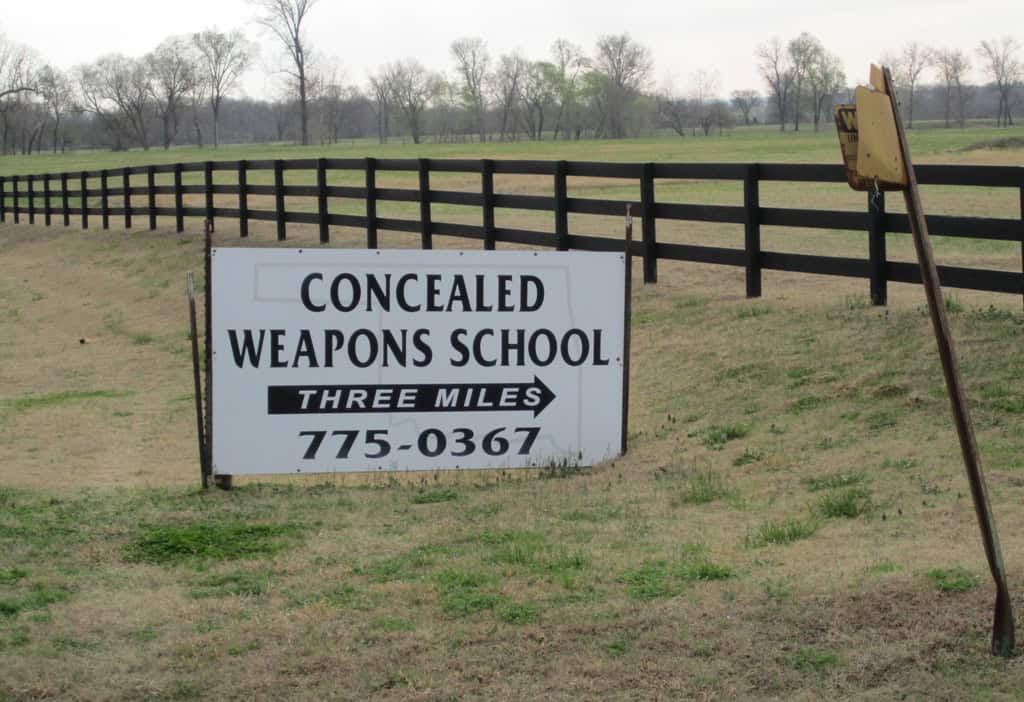
As of January 1, 2024, only eight states require safety training before you can purchase and carry a firearm. The District of Columbia is among the states that require a safety course just for handguns but not for long guns. Only California looks to be the most progressive in curtailing gun ownership without some training or course.
Reciprocity Agreements
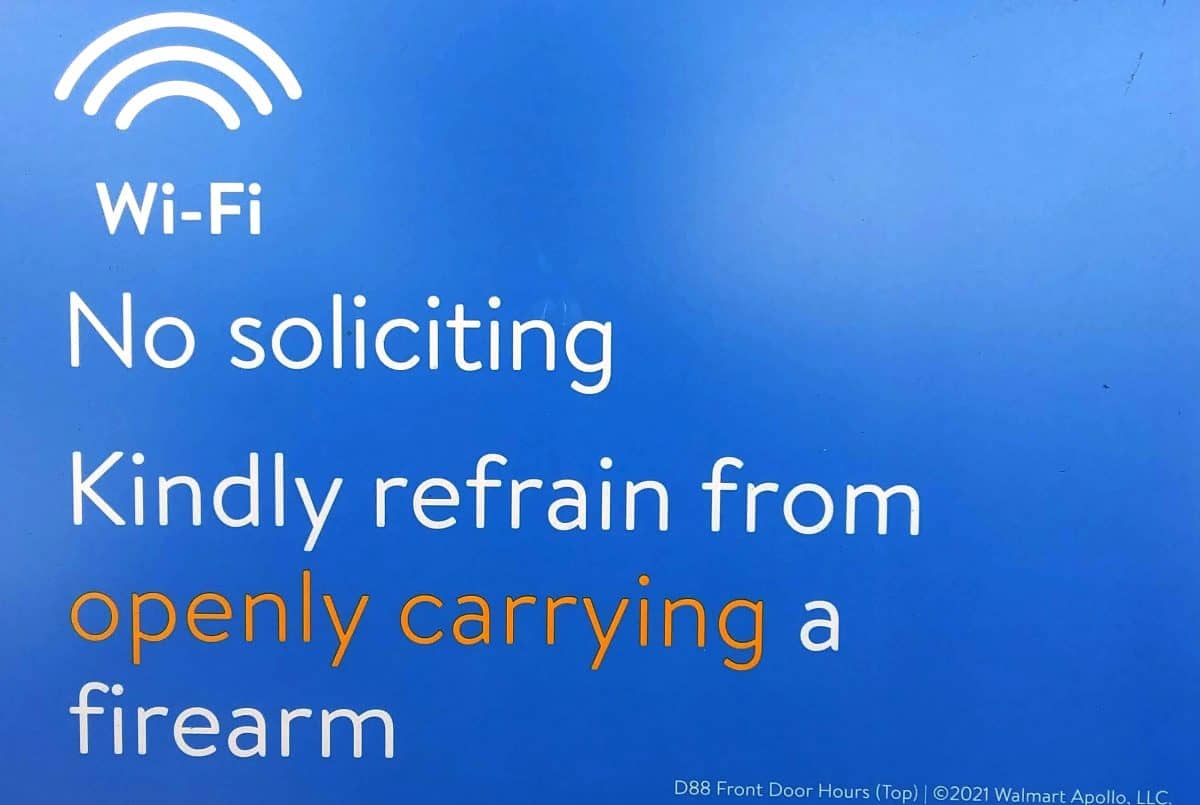
One notable aspect of both open and concealed carry laws is reciprocity. In this case, there is some reciprocity between some states but not all of them. For example, Idaho will recognize an Oregon gun permit, but the reverse is not true, and Oregon will not recognize an Idaho permit.
Many states will not recognize out-of-state concealed or open carry permits, so it’s highly recommended that you research before traveling out of state. You should be familiar with the laws of each state you will be traveling through or subject to fines and arrest.
Alabama

Open carry is legal for both handguns and long guns in Alabama. Since 2023, it has also been legal to carry a concealed firearm in the state without a permit. Alabama has the fourth highest rate of gun deaths in the United States, with 26.4 deaths per 100,000 people (1,315 deaths total).
Alaska

Open carry is legal for both handguns and long guns in Alaska. Since 2003, it has also been legal to carry a concealed firearm in the state without a permit. Alaska has the sixth highest rate of gun deaths in the United States, with 25.2 deaths per 100,000 people (182 deaths total).
Arizona

Open carry is legal for both handguns and long guns in Arizona. Since 2010, it has also been legal to carry a concealed handgun in the state without a permit. Arizona has the seventeenth-highest rate of gun deaths in the United States, with 18.3 deaths per 100,000 people (1,365 deaths total).
Arkansas

Open carry is legal for both handguns and long guns in Arkansas. Since 2013, it has also been legal to carry a concealed handgun in the state without a permit. Permitless concealed carry has been further strengthened in subsequent years as well. Arkansas has the eighth-highest rate of gun deaths in the United States, with 23.3 deaths per 100,000 people (698 deaths total).
California

Open carry for both handguns and long guns is prohibited in California. It is also illegal to carry a concealed handgun in the state without a permit. California has the eighth lowest rate of gun deaths in the United States, with 9.0 deaths per 100,000 people (3,576 deaths total).
Colorado

Open carry is legal for both handguns and long guns in Colorado. However, it is illegal to carry a concealed handgun in the state without a permit. Colorado has the eighteenth-highest rate of gun deaths in the United States, with 17.8 deaths per 100,000 people (1,064 deaths total).
Connecticut

Open carry of long guns is legal in Connecticut, but a permit is required for open carry of handguns. In addition, it is illegal to carry a concealed handgun in the state without a license. Connecticut has the sixth lowest rate of gun deaths in the United States, with 6.7 deaths per 100,000 people (248 deaths total).
Delaware

Open carry of both handguns and long guns is legal in Delaware. However, it is illegal to carry a concealed handgun in the state without a permit. Delaware has the third highest rate of gun deaths in the United States, with 17.8 deaths per 100,000 people (158 deaths total).
Florida

Open carry is prohibited for both handguns and long guns in Florida. However, since July 1, 2023, carrying a concealed handgun in the state has been legal without a permit. Florida has the seventeenth lowest rate of gun deaths in the United States, with 14.1 deaths per 100,000 people (3,142 deaths total).
Georgia

Open carry is legal for both handguns and long guns in Georgia. Since 2022, it has also been legal to carry a concealed handgun in the state without a permit. Georgia has the fourteenth highest rate of gun deaths in the United States, with 20.3 deaths per 100,000 people (2,200 deaths total).
Hawaii

Permits are required for open carry of both handguns and long guns in Hawaii. In addition, carrying a concealed handgun in the state is illegal without a permit. Hawaii has the second lowest rate of gun deaths in the United States, with 4.8 deaths per 100,000 people (71 deaths total).
Idaho

Open carry is legal for both handguns and long guns in Idaho. Since 2016, it has also been legal to carry a concealed handgun in the state without a permit. Idaho has the twenty-fifth highest rate of gun deaths in the United States, with 16.3 deaths per 100,000 people (309 deaths total).
Illinois
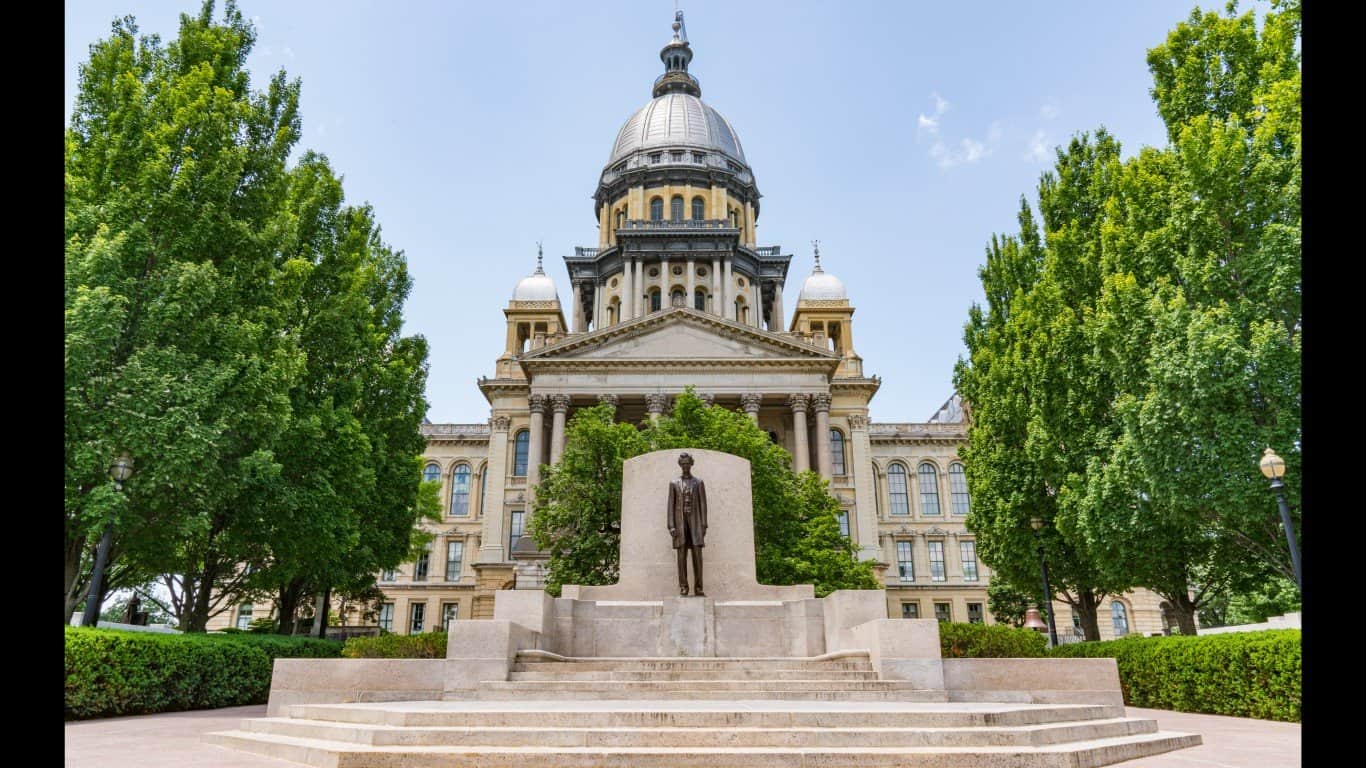
Open carry for both handguns and long guns is prohibited in Illinois. It is also illegal to carry a concealed handgun in the state without a permit. Illinois has the twenty-fifth lowest rate of gun deaths in the United States, with 16.1 deaths per 100,000 people (1,995 deaths total).
Indiana

Open carry is legal for both handguns and long guns in Indiana. Since 2022, it has also been legal to carry a concealed handgun in the state without a permit. Indiana has the sixteenth highest rate of gun deaths in the United States, with 18.4 deaths per 100,000 people (1,251 deaths total).
Iowa
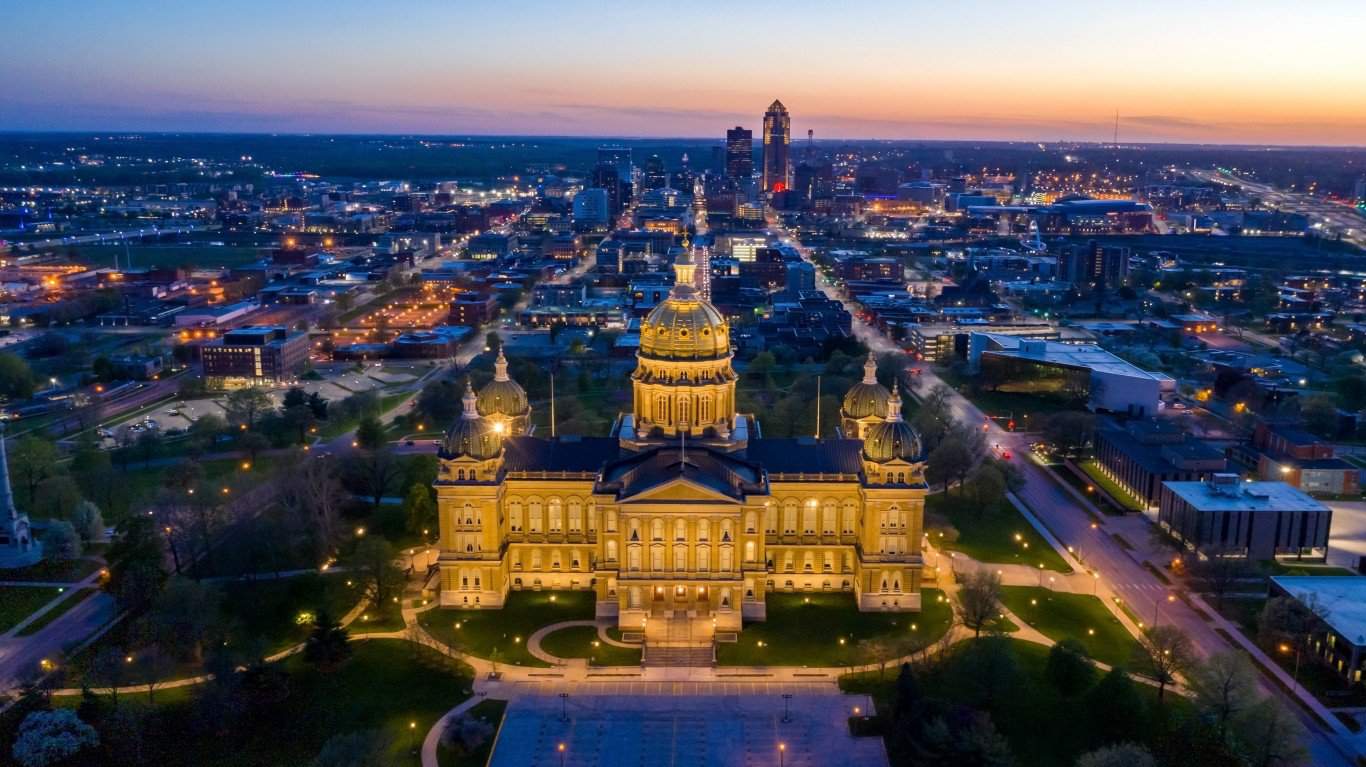
Open carry is legal for both handguns and long guns in Iowa. Since 2021, it has also been legal to carry a concealed handgun in the state without a permit. Iowa has the eleventh lowest rate of gun deaths in the United States, with 11.2 deaths per 100,000 people (364 deaths total).
Kansas
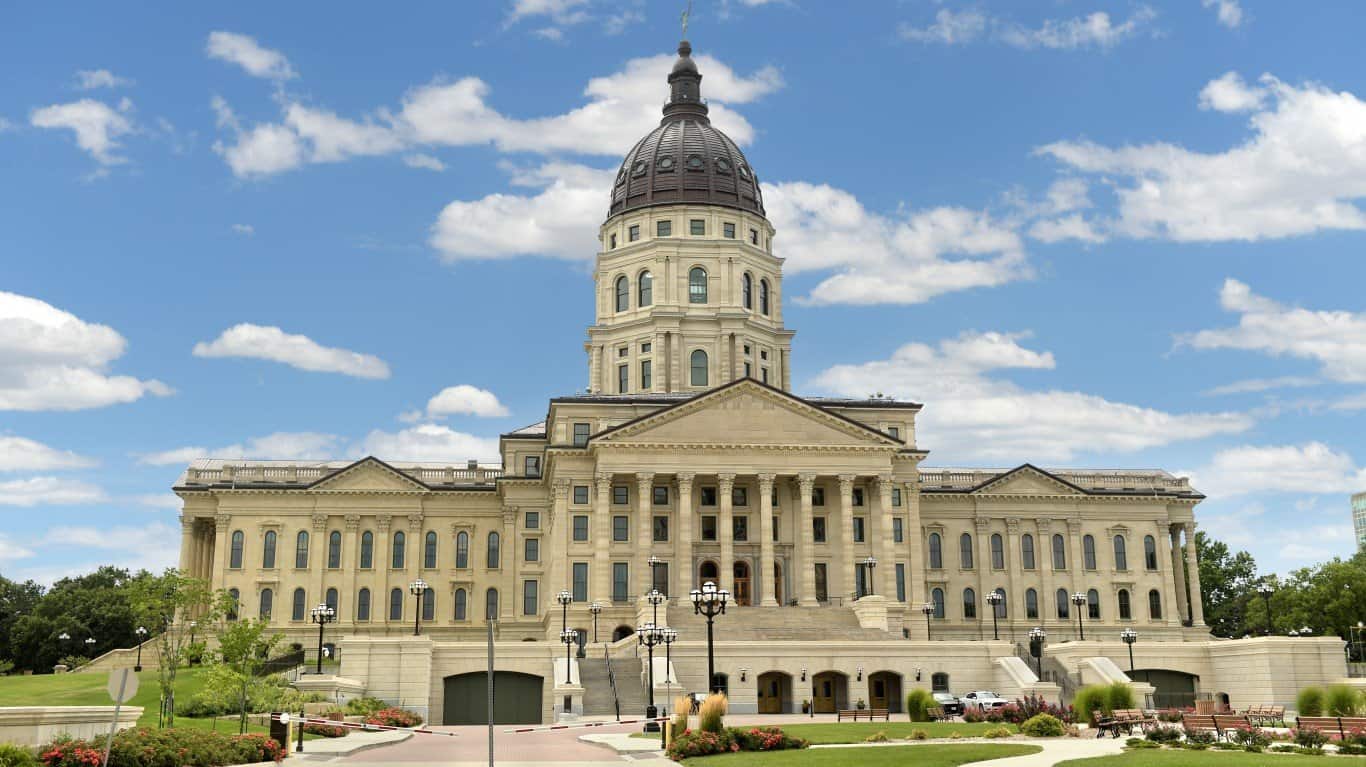
Open carry is legal for both handguns and long guns in Kansas. Since 2015, it has also been legal to carry a concealed handgun in the state without a permit. Kansas has the twenty-first highest rate of gun deaths in the United States, with 17.3 deaths per 100,000 people (503 deaths total).
Kentucky

Open carry is legal for both handguns and long guns in Kentucky. Since 2019, it has also been legal to carry a concealed handgun in the state without a permit. Kentucky has the thirteenth highest rate of gun deaths in the United States, with 21.1 deaths per 100,000 people (947 deaths total).
Louisiana

Open carry is legal for both handguns and long guns in Louisiana. However, since 2022, only residents with military service can carry a concealed handgun. Louisiana has the second highest rate of gun deaths in the United States, with 29.1 deaths per 100,000 people (1,314 deaths total).
Maine

Open carry is legal for both handguns and long guns in Maine. Since 2015, it has also been legal to carry a concealed handgun in the state without a permit. Maine has the fourteenth lowest rate of gun deaths in the United States, with 12.6 deaths per 100,000 people (178 deaths total).
Maryland

Open carry of long guns is legal in Maryland, but a permit is required for open carry of handguns. In addition, carrying a concealed handgun in the state is illegal without a permit. Maryland has the twenty-second lowest rate of gun deaths in the United States, with 15.2 deaths per 100,000 people (915 deaths total).
Massachusetts

A permit is required for open carry of both handguns and long guns in Massachusetts. In addition, carrying a concealed handgun in the state is illegal without a permit. Massachusetts has the lowest rate of gun deaths in the United States, with 3.4 deaths per 100,000 people (247 deaths total).
Michigan
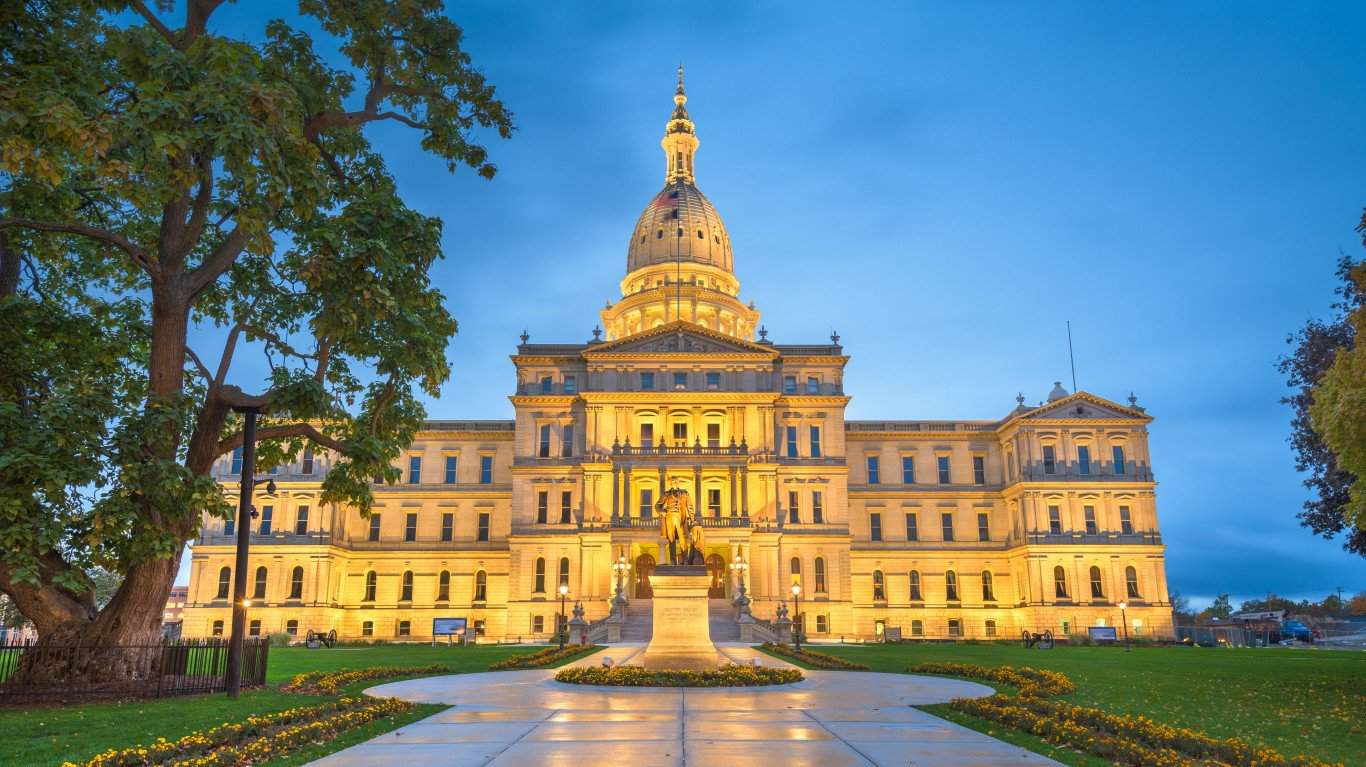
Open carry is legal for both handguns and long guns in Michigan. However, it is illegal to carry a concealed handgun in the state without a permit. Michigan has the twenty-third lowest rate of gun deaths in the United States, with 15.4 deaths per 100,000 people (1,544 deaths total).
Minnesota

A permit is required for open carry of both handguns and long guns in Minnesota. In addition, carrying a concealed handgun in the state is illegal without a permit. Minnesota has the ninth lowest rate of gun deaths in the United States, with 10.0 deaths per 100,000 people (573 deaths total).
Mississippi

Open carry is legal for both handguns and long guns in Mississippi. Since 2016, it has also been legal to carry a concealed handgun in the state without a permit. Mississippi has the highest rate of gun deaths in the United States, with 33.9 deaths per 100,000 people (962 deaths total).
Missouri

Open carry is legal for both handguns and long guns in Missouri. Since 2017, it has also been legal to carry a concealed handgun in the state without a permit. Missouri has the ninth-highest rate of gun deaths in the United States, with 23.2 deaths per 100,000 people (1,414 deaths total).
Montana

Open carry is legal for both handguns and long guns in Montana. Since 2021, it has also been legal to carry a concealed handgun in the state without a permit. Montana has the seventh-highest rate of gun deaths in the United States, with 25.1 deaths per 100,000 people (280 deaths total).
Nebraska

Open carry is legal for both handguns and long guns in Nebraska. Since September 10, 2023, it has also been legal to carry a concealed handgun in the state without a permit. Nebraska has the tenth lowest rate of gun deaths in the United States, with 10.3 deaths per 100,000 people (200 deaths total).
Nevada

Open carry is legal for both handguns and long guns in Nevada. However, it is illegal to carry a concealed handgun in the state without a permit. Nevada has the fourth highest rate of gun deaths in the United States, with 19.8 deaths per 100,000 people (633 deaths total).
New Hampshire

Open carry is legal for both handguns and long guns in New Hampshire. Since 2017, it has also been legal to carry a concealed handgun in the state without a permit. New Hampshire has the seventh lowest rate of gun deaths in the United States, with 8.3 deaths per 100,000 people (123 deaths total).
New Jersey

A permit for open carry of long guns is required in New Jersey, and open carry of handguns is prohibited. In addition, it is also illegal to carry a concealed handgun in the state without a permit. New Jersey has the third lowest rate of gun deaths in the United States, with 5.2 deaths per 100,000 people (475 deaths total).
New Mexico

Open carry is legal for both handguns and long guns in New Mexico. However, it is illegal to carry a concealed handgun in the state without a permit. New Mexico has the third highest rate of gun deaths in the United States, with 27.8 deaths per 100,000 people (578 deaths total).
New York

A permit for open carry of long guns is required in New York, and open carry of handguns is prohibited. In addition, it is also illegal to carry a concealed handgun in the state without a permit. New York has the fourth lowest rate of gun deaths in the United States, with 5.4 deaths per 100,000 people (1,078 deaths total).
North Carolina

Open carry is legal for both handguns and long guns in North Carolina. However, it is illegal to carry a concealed handgun in the state without a permit. North Carolina has the twentieth-highest rate of gun deaths in the United States, with 17.3 deaths per 100,000 people (1,839 deaths total).
North Dakota
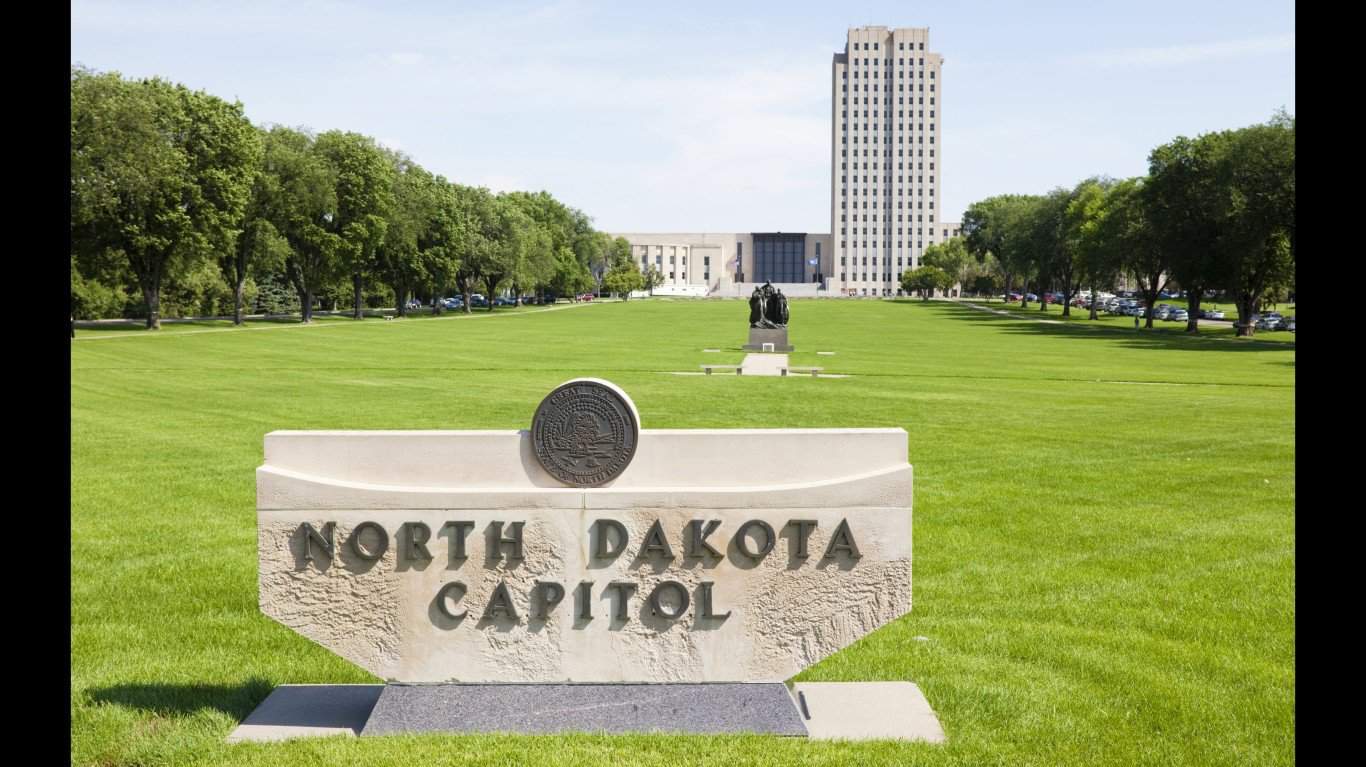
Open carry is legal for both handguns and long guns in North Dakota. Since 2017, it has also been legal to carry a concealed handgun in the state without a permit. North Dakota has the twenty-second highest rate of gun deaths in the United States, with 16.8 deaths per 100,000 people (128 deaths total).
Ohio

Open carry is legal for both handguns and long guns in Ohio. Since 2022, it has also been legal to carry a concealed handgun in the state without a permit. Ohio has the twenty-fourth highest rate of gun deaths in the United States, with 16.5 deaths per 100,000 people (1,911 deaths total).
Oklahoma

Open carry is legal for both handguns and long guns in Oklahoma. Since 2019, it has also been legal to carry a concealed handgun in the state without a permit. Oklahoma has the twelfth highest rate of gun deaths in the United States, with 21.2 deaths per 100,000 people (836 deaths total).
Oregon

Open carry is legal for both handguns and long guns in Oregon. However, it is illegal to carry a concealed handgun in the state without a permit. Oregon has the twenty-first lowest rate of gun deaths in the United States, with 14.9 deaths per 100,000 people (670 deaths total).
Pennsylvania

Open carry is legal for both handguns and long guns in Pennsylvania. However, it is illegal to carry a concealed handgun in the state without a permit. Pennsylvania has the twentieth-lowest rate of gun deaths in the United States, with 14.8 deaths per 100,000 people (1,905 deaths total).
Rhode Island

Open carry of long guns is legal in Rhode Island, but a permit is required to carry handguns. In addition, carrying a concealed handgun in the state is illegal without a permit. Rhode Island has the fifth lowest rate of gun deaths in the United States, with 5.6 deaths per 100,000 people (64 deaths total).
South Carolina

Open carry of long guns is legal in South Carolina, but a permit is required for open carry of handguns. In addition, carrying a concealed handgun in the state is illegal without a permit. South Carolina has the eleventh highest rate of gun deaths in the United States, with 22.4 deaths per 100,000 people (1,136 deaths total).
South Dakota

Open carry is legal for both handguns and long guns in South Dakota. Since 2019, it has also been legal to carry a concealed handgun in the state without a permit. South Dakota has the eighteenth lowest rate of gun deaths in the United States, with 14.3 deaths per 100,000 people (128 deaths total).
Tennessee

Open carry is legal for both handguns and long guns in Tennessee. Since 2021, it has also been legal to carry a concealed handgun in the state without a permit. Tennessee has the tenth-highest rate of gun deaths in the United States, with 22.8 deaths per 100,000 people (1,569 deaths total).
Texas
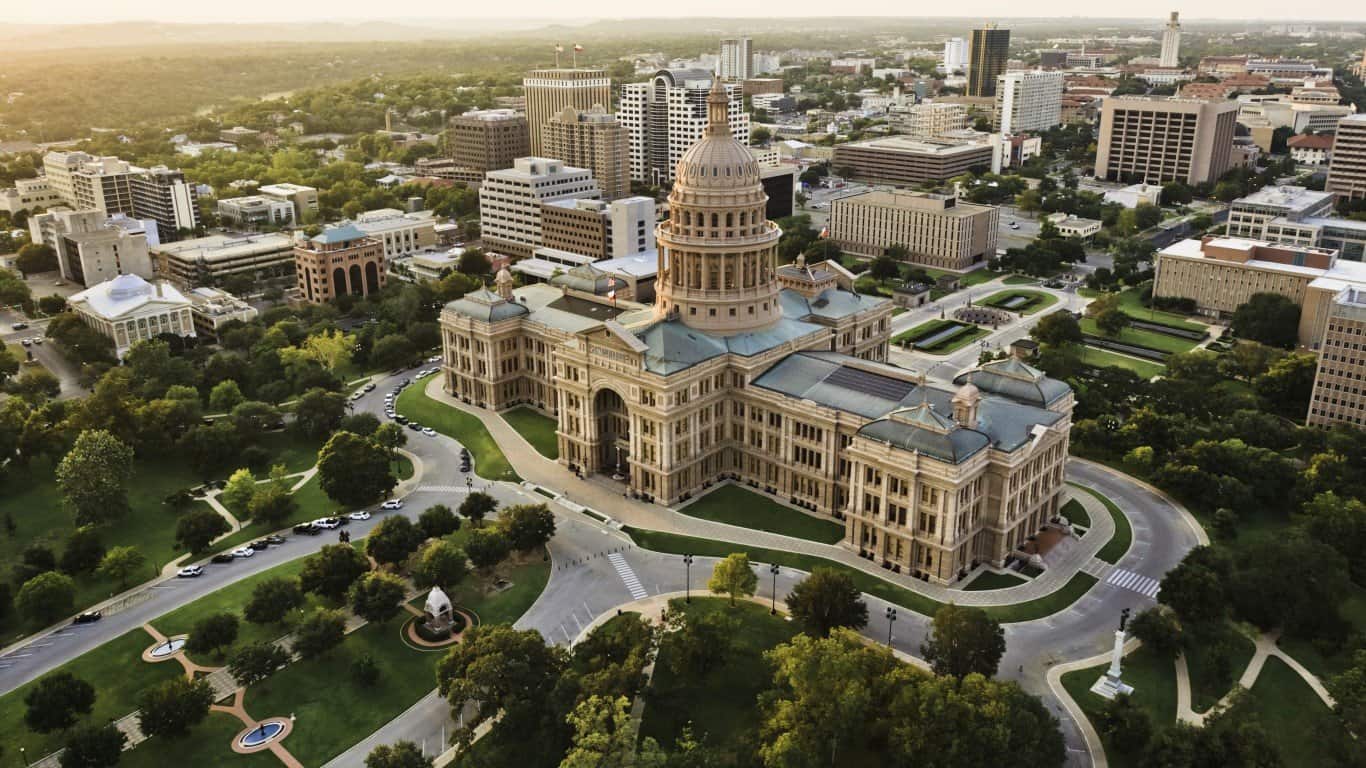
Open carry is legal for both handguns and long guns in Texas. Since 2021, it has also been legal to carry a concealed handgun in the state without a permit. Texas has the twenty-fourth lowest rate of gun deaths in the United States, with 15.6 deaths per 100,000 people (4,613 deaths total).
Utah
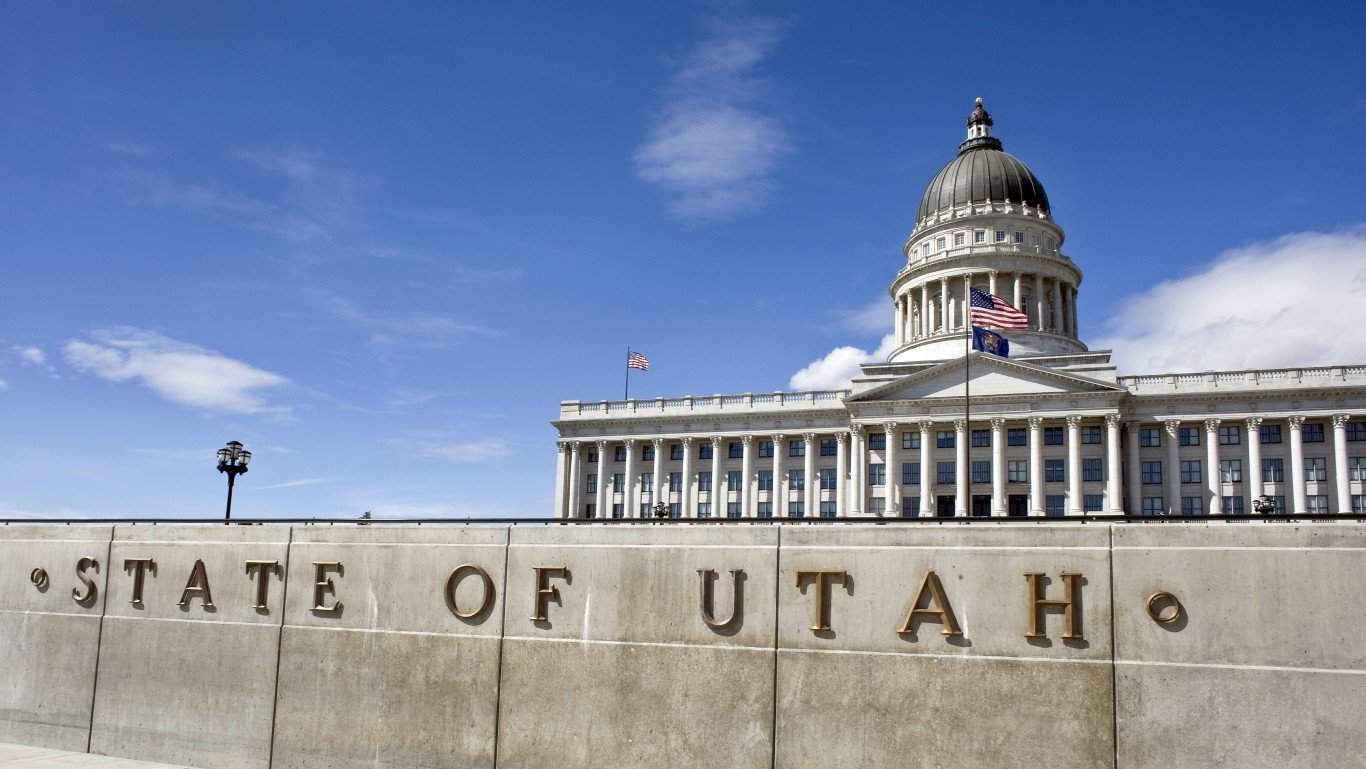
Open carry is legal for both handguns and long guns in Utah. Since 2021, it has also been legal to carry a concealed handgun in the state without a permit. Utah has the sixteenth-lowest rate of gun deaths in the United States, with 13.9 deaths per 100,000 people (450 deaths total).
Vermont

Open carry is legal for both handguns and long guns in Vermont. Since 1791, it has also been legal to carry a concealed handgun in the state without a permit. Vermont has the thirteenth highest rate of gun deaths in the United States, with 11.9 deaths per 100,000 people (83 deaths total).
Virginia

Open carry is legal for both handguns and long guns in Virginia. However, it is illegal to carry a concealed handgun in the state without a permit. Virginia has the nineteenth-lowest rate of gun deaths in the United States, with 14.3 deaths per 100,000 people (1,248 deaths total).
Washington

Open carry is legal for both handguns and long guns in Washington. However, it is illegal to carry a concealed handgun in the state without a permit. Washington has the twelfth lowest rate of gun deaths in the United States, with 11.2 deaths per 100,000 people (896 deaths total).
West Virginia

Open carry is legal for both handguns and long guns in West Virginia. Since 2016, it has also been legal to carry a concealed handgun in the state without a permit. West Virginia has the nineteenth-highest rate of gun deaths in the United States, with 17.3 deaths per 100,000 people (319 deaths total).
Wisconsin
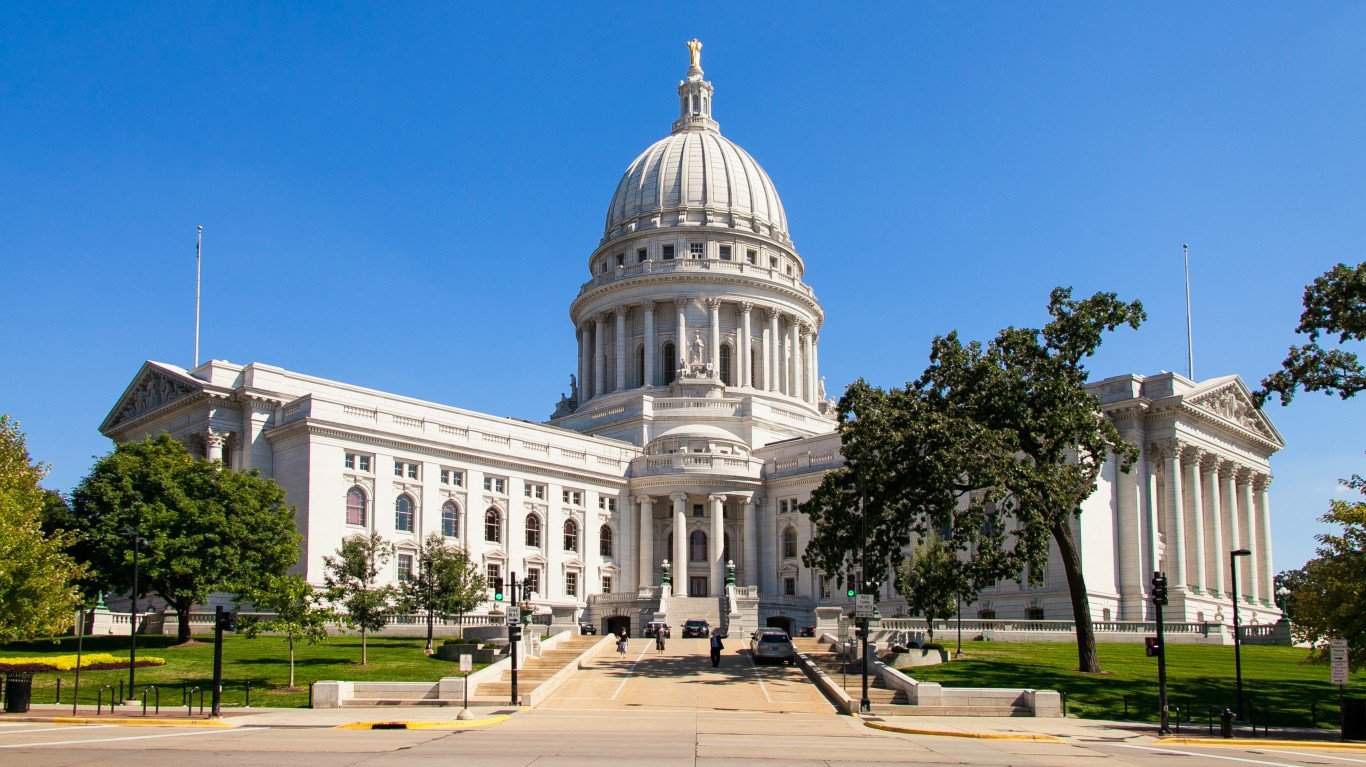
Open carry is legal for both handguns and long guns in Wisconsin. However, it is illegal to carry a concealed handgun in the state without a permit. Wisconsin has the fifteenth lowest rate of gun deaths in the United States, with 13.5 deaths per 100,000 people (793 deaths total).
Wyoming
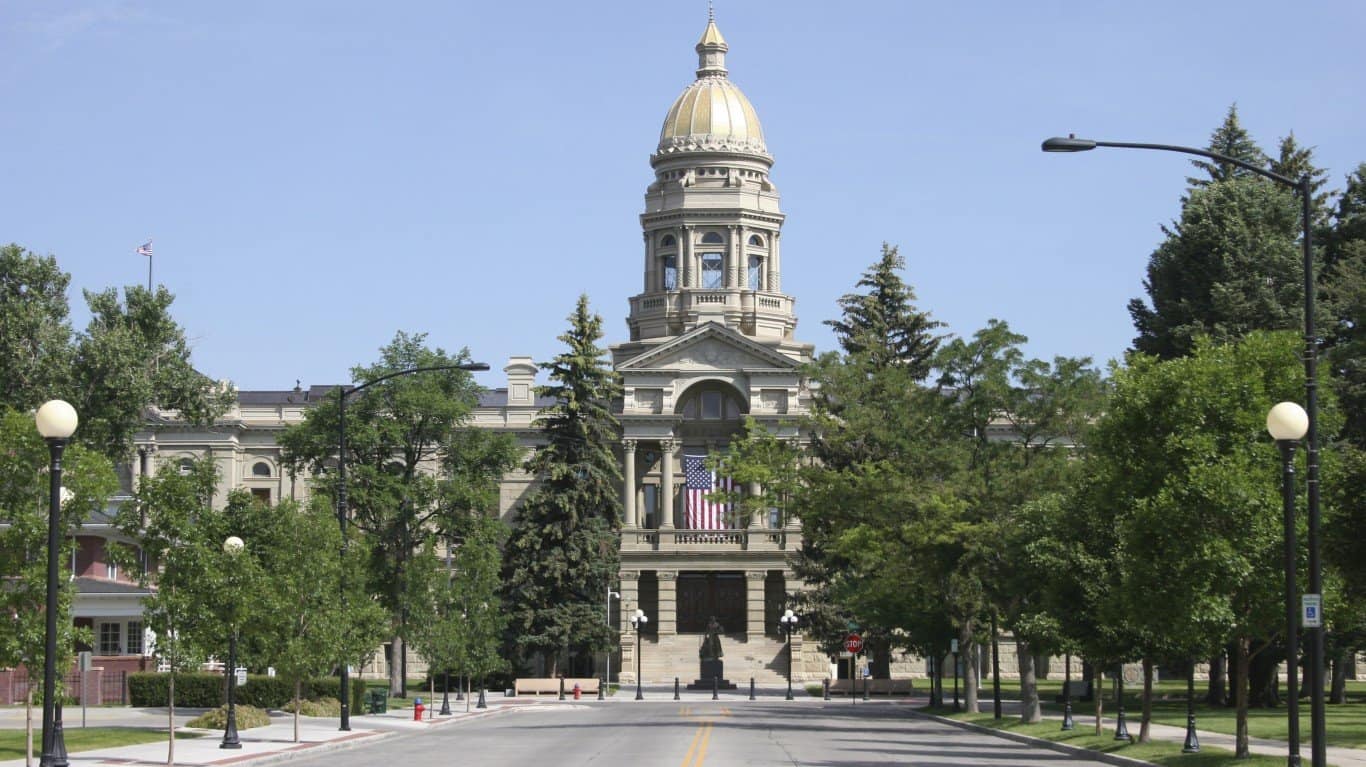
Open carry is legal for both handguns and long guns in Wyoming. Since 2011, it has also been legal to carry a concealed handgun in the state without a permit. Wyoming has the fifth highest rate of gun deaths in the United States, with 26.1 deaths per 100,000 people (155 deaths total).
The image featured at the top of this post is ©GABRIEL BOUYS / AFP via Getty Images.
